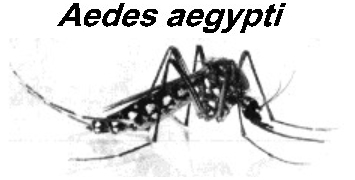Biological Clocks in Mosquitoes
|
 A
pan-tropical species, type locality Egypt, with its geographical limits
regarded as being the 24.8° C minimum isotherm by Christophers
(1960). This approximates to latitudes 40°N and 40°S (Stone et al.,
1959). Two subspecies were studied - ssp aegypti and ssp
formosus (Mattingly, 1966), with two strains of each - LSHTM and
Ilobi, and Bwamba and West Nile respectively.
A
pan-tropical species, type locality Egypt, with its geographical limits
regarded as being the 24.8° C minimum isotherm by Christophers
(1960). This approximates to latitudes 40°N and 40°S (Stone et al.,
1959). Two subspecies were studied - ssp aegypti and ssp
formosus (Mattingly, 1966), with two strains of each - LSHTM and
Ilobi, and Bwamba and West Nile respectively.
The fundamental circadian rhythm underlying flight activity was examined in detail by Taylor & Jones (1969); who used the LSHTM strain. The Ilobi strain was used in the major series of studies of oviposition timing, by P.S. Corbet, J.D. Gillett and A.J. Haddow (summarised by Gillett, 1962). Subsequent laboratory studies of flight activity have been by Jones (1981), on the effect of mating and the gonotrophic cycle; and Rowland & Lindsay (1986), on the effect of parasite infection by a filarial nematode, Brugia pahangi. In view of the observation by Jones (1981) that insemination reduced activity and, to some extent, altered its timing, it is worth noting that the experiments with LSHTM (Taylor, 1969a; Taylor & Jones, 1969) were with inseminated females (checked by spermathecal examination after the experiments).
The details and results for the two strains of each of the
subspecies can be found by clicking
type-form, LSHTM
strain
type-form, Ilobi
strain
ssp formosus
wild-form, Bwamba strain
ssp formosus
wild-form, West Nile strain
The only LD regime used by others who have studied Ae. aegypti is LD 12:12 (Jones, 1981; Rowland & Lindsay, 1986). Their recordings of activity differ from the LSHTM results solely because of the minor changes that follow insemination (Jones 1981). The LSHTM results (see Figure 1) are for inseminated females and, thus, show only a low level of M activity; virgins show a rather stronger bimodal E'-M pattern.
Curiously, Jones (1981) found that sugar-fed inseminated females showed very little activity and it was his blood-fed females which showed activity very similar to the LSHTM results. In his experiments, however, Jones provided only a 1% sucrose source in the recording chambers. This may have been inadequate, as Taylor & Jones (1969) had found it essential to provide both a glucose/sucrose mixture and a plain water source. Rowland & Lindsay (1986) also provided a source of plain water.
The other strain of ssp aegypti, Ilobi (see Figure 2), closely resembled LSHTM, but the two ssp formosus strains, Bwamba (see Figure 3) and West Nile (see Figure 4), both showed a marked bimodal M-E' pattern in LD 12:12. The bimodal activity of the formosus strains became even more marked in the extreme LD regimes. The shift forward of the E' peaks in long days, first reported for LSHTM (Taylor & Jones 1969), occurred also in the other three strains.
Petersen (1977) compared aspects of the biology of the two subspecies at Mombasa, on the Kenyan coast. He described ssp aegypti as being mostly coastal in East Africa, breeding indoors in earthenware storage jars and, thus, doing so year-round. Similarly it fed mainly indoors, being strongly anthropophilic and anautogenous. In contrast, he described ssp formosus as being confined to sub-Saharan Africa and breeding mainly outdoors, which tends to limit it to wet-season breeding. It rarely feeds on humans indoors and only occasionally outdoors, being facultatively autogenous (although poorly so despite the regular source of blood being unknown). A genetic analysis of field-inseminated females indicated that mating was in a positive assortative fashion, i.e. like mating with like, and although hybridisation did occur it was rare. Petersen's general observation was that the two subspecies seem to show more specialised behaviour where they are in contact than when they occur separately.
|
©1998, 2010 - Brian Taylor CBiol FSB FRES 11, Grazingfield, Wilford, Nottingham, NG11 7FN, U.K. Comments to dr.b.taylor@ntlworld.com |
href="\crhtml\aedaeg1.htm"